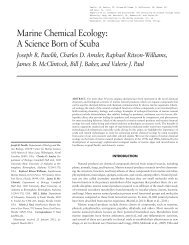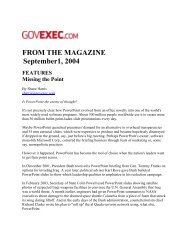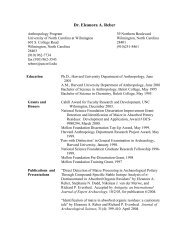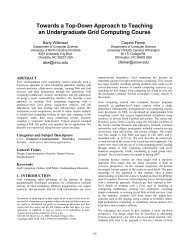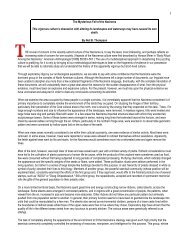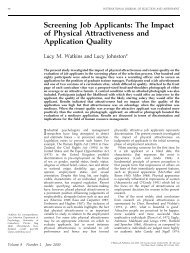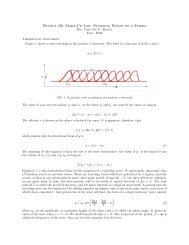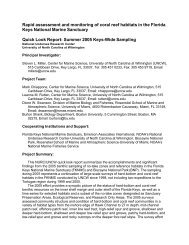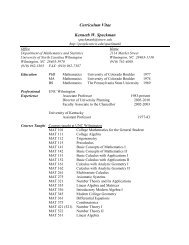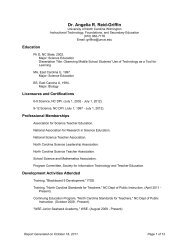Hargreaves, "Perceptions of Ethnic Difference in Post-War France"
Hargreaves, "Perceptions of Ethnic Difference in Post-War France"
Hargreaves, "Perceptions of Ethnic Difference in Post-War France"
You also want an ePaper? Increase the reach of your titles
YUMPU automatically turns print PDFs into web optimized ePapers that Google loves.
<strong>Perceptions</strong> <strong>of</strong> <strong>Ethnic</strong> <strong>Difference</strong><br />
<strong>in</strong> <strong>Post</strong>-<strong>War</strong> FTance<br />
Alec G. <strong>Hargreaves</strong><br />
INTRODUCTION<br />
The writers discussed <strong>in</strong> this book all have their orig<strong>in</strong>s <strong>in</strong> the broad field <strong>of</strong><br />
<strong>in</strong>ternational migration and the m<strong>in</strong>ority ethnic groups associated with it. While<br />
some were born <strong>in</strong> France and are not therefore immigrants <strong>in</strong> the true sense,<br />
others migrated to France as adults. Yet few, if any, would customarily be described<br />
<strong>in</strong> French as 1criva<strong>in</strong>s immigrds (immigrant writers). If this expression<br />
sounds almost oxymoronic, it is because its component terms carry semantic<br />
accretions acquired <strong>in</strong> very different fields <strong>of</strong> usage. Where an dcriva<strong>in</strong> operates<br />
<strong>in</strong> the field <strong>of</strong> culture, <strong>of</strong>ten <strong>of</strong> an 6lite k<strong>in</strong>d, immigrds are generally regarded as<br />
economic actors concentrated at the lower end <strong>of</strong> the social scale.<br />
Shictly speak<strong>in</strong>g, any person liv<strong>in</strong>g <strong>in</strong> a country other than that <strong>in</strong><br />
which he or she was born is an immigrant. If, <strong>in</strong> everyday discourse, the term is<br />
applied only to certa<strong>in</strong> types <strong>of</strong> immigrants--and at the same time to some nonimmigrants--this<br />
is because <strong>of</strong> the historical context <strong>in</strong> which its usage has been<br />
forged. The aims <strong>of</strong> this chapter are to provide an outl<strong>in</strong>e <strong>of</strong> that context and to<br />
explore some <strong>of</strong> the ma<strong>in</strong> terms <strong>in</strong> which the processes <strong>of</strong> <strong>in</strong>ternational migration<br />
and m<strong>in</strong>ority ethnic settlement have been conceptualized by the majority<br />
ethnic population <strong>in</strong> post-war France. Even when they are not themselves perceived<br />
as "immigrants," m<strong>in</strong>ority ethnic authors are <strong>in</strong> vary<strong>in</strong>g degrees conscious<br />
<strong>of</strong> this context. Moreover, as they are sometimes taken for "immigrants"<br />
(as commonly understood <strong>in</strong> France), those among them who are not <strong>in</strong> any real<br />
sense immigrants are nevertheless deeply affected by the perceptions <strong>of</strong> ethnic<br />
difference travers<strong>in</strong>g French society. We therefore need to be aware <strong>of</strong> this context<br />
if we are to fullv understand their works.
8 Immigrant Narratives <strong>in</strong> Contemporary France<br />
This chapter is divided <strong>in</strong>to three ma<strong>in</strong> parts. The first <strong>of</strong> these provides<br />
a historical overview. The second focuses on key words used (as well as<br />
some not used) <strong>in</strong> referr<strong>in</strong>g to immigrants and their descendants, while the f<strong>in</strong>al<br />
section looks at the conceptualization <strong>of</strong> the processes <strong>of</strong> social and cultural<br />
change associated with m<strong>in</strong>ority ethnic settlement.<br />
HISTORY<br />
Historically, two ma<strong>in</strong> phases may be dist<strong>in</strong>guished with<strong>in</strong> the postwar<br />
period. The first <strong>of</strong> these stretches from the liberation <strong>in</strong> 1944 to the first oil<br />
crisis <strong>of</strong> 1973, which marked the end <strong>of</strong> what subsequently became known as les<br />
trente glorieuses, a thirty-year period marked (particularly <strong>in</strong> the second half) by<br />
exceptionally high and susta<strong>in</strong>ed economic growth. Dur<strong>in</strong>g this first phase, immigration<br />
was seldom discussed outside specialist adm<strong>in</strong>istrative circles. It was<br />
a period <strong>of</strong> loose immigration controls, and brought a steady shift <strong>in</strong> the ethnic<br />
balance <strong>of</strong> the immigrant population, with post-colonial m<strong>in</strong>orities becom<strong>in</strong>g<br />
more visible than Europeans. The second phase, runn<strong>in</strong>g from 1974 to the present,<br />
has been characterized by lower and more fitful economic growth and pa<strong>in</strong>ful<br />
changes <strong>in</strong> the labor market, with record levels <strong>of</strong> unemployment and a generalized<br />
climate <strong>of</strong> economic <strong>in</strong>security. It has brought draconian immigration<br />
controls and seen "immigration"--understood <strong>in</strong> France as a label encompass<strong>in</strong>g<br />
not only population movements but also the processes <strong>of</strong> social <strong>in</strong>teraction result<strong>in</strong>g<br />
from m<strong>in</strong>ority ethnic settlement--explode <strong>in</strong>to the forefront <strong>of</strong> political<br />
debate and across a grow<strong>in</strong>g range <strong>of</strong> social and cultural spheres.<br />
As France emerged from Nazi occupation, the ma<strong>in</strong> problem posed by<br />
immigration was that there was not enough <strong>of</strong> it. The war had left a trail <strong>of</strong> destruction<br />
and depleted the ranks <strong>of</strong> able-bodied workers. Reconstruction would<br />
therefore require assistance from workers brought <strong>in</strong> from abroad. While this<br />
basic premise was accepted on virtually all sides, a vigorous debate took place<br />
among specialist government advisers concern<strong>in</strong>g the relative merits <strong>of</strong> temporary<br />
labor migration compared with permanent family settlement. Some argued<br />
that family migration was needed because France faced not only a short-term<br />
reconstruction problem but also a more structural demographic deficit. In contrast<br />
with her faster grow<strong>in</strong>g neighbors--most obviously, her arch-rival<br />
Germany--France had experienced a long period <strong>of</strong> population stagnation. Family<br />
settlement by immigrants would help to swell not only the labor force but<br />
also the long-term demographic pr<strong>of</strong>ile <strong>of</strong> the country.<br />
While there was by no means unanimity on the need for permanent<br />
settlement <strong>of</strong> this k<strong>in</strong>d, practically all those <strong>in</strong>volved <strong>in</strong> the debate agreed that,<br />
as <strong>in</strong> the past, it would be preferable to recruit immigrants <strong>in</strong> Europe rather than<br />
overseas. There was a general consensus <strong>in</strong> favor firstly <strong>of</strong> west Europeans such<br />
as Italians and Belgians, followed by central and eastern Europeans, with Africans<br />
and Asians the least favored groups. At the same time, the horrors associated<br />
with the racist policies recently pursued by Nazi Germany made some<br />
(though not all) <strong>in</strong> government circles hesitate to adopt an immigration policy<br />
based on openly ethnic criteria.<br />
A rather bluned compromise eventually emerged <strong>in</strong> which a legal<br />
framework facilitat<strong>in</strong>g family settlement was put <strong>in</strong> place without any explicitly<br />
codified ethnic hierarchy. At the same time, the authorities responsible for recruit<strong>in</strong>g<br />
immigrants effectively worked to a de facto ethnic agenda by prioritiz-
<strong>Ethnic</strong> <strong>Difference</strong> <strong>in</strong> <strong>Post</strong>-<strong>War</strong> France 9<br />
<strong>in</strong>g neighbor<strong>in</strong>g countries such as Italy.' The practicalities <strong>of</strong> public policy were<br />
also at odds with its legalities <strong>in</strong> another important respect. Although family<br />
immigration was <strong>of</strong>ficially welcomed, very little was done to assist <strong>in</strong>com<strong>in</strong>g<br />
families <strong>in</strong> vital matters such as the provision <strong>of</strong> adequate hous<strong>in</strong>g. The state<br />
was ma<strong>in</strong>ly concemed with ensur<strong>in</strong>g that France had an adequate labor supply.<br />
Beyond that narrow economic focus, immigrants were left to fend largely for<br />
themselves.<br />
Dur<strong>in</strong>g the 1950s and 1960s, one <strong>of</strong> the effects <strong>of</strong> this was to be the<br />
proliferation <strong>of</strong> bidonvilles (shantytowns), groups <strong>of</strong> improvised shacks thrown<br />
up by immigrants on vacant land with little or no access to basic utilities such<br />
as runn<strong>in</strong>g water and electricity. It was not until the 1970s that the authorities<br />
decided to eradicate these dwell<strong>in</strong>gs, mov<strong>in</strong>g their <strong>in</strong>habitants <strong>in</strong>itially to cittis<br />
de transit, slightly better quality but still "temporary" accommodations <strong>in</strong><br />
which some families found themselves trapped for ten years or more. Eventually,<br />
most moved on to high-rise, low-quality hous<strong>in</strong>g projects generally located<br />
<strong>in</strong> outly<strong>in</strong>g urban areas, where they rema<strong>in</strong> concentrated today.'<br />
One further development <strong>in</strong> the early post-war period needs to be mentioned.<br />
In 1947, France granted a new status to her largest North African colony,<br />
Algeria, which gave the Muslim majority <strong>of</strong> the population equal freedom <strong>of</strong><br />
movement alongside the settler m<strong>in</strong>ority. Designed as a symbolic measure<br />
aimed at help<strong>in</strong>g stem the grow<strong>in</strong>g move towards decolonization, this provision<br />
was not <strong>in</strong>tended to encourage migration, but it had the effect <strong>of</strong> exempt<strong>in</strong>g A1-<br />
gerians from immigration controls <strong>in</strong> metropolitan France, and grow<strong>in</strong>g numbers<br />
<strong>of</strong> them took advantage <strong>of</strong> this to seek work there. As Italians and other<br />
Europeans proved less attracted to France than <strong>in</strong> the pre-war period, a de facto<br />
shift <strong>in</strong> the ethnic balance <strong>of</strong> migratory flows began to take place, a shift that<br />
went aga<strong>in</strong>st the gra<strong>in</strong> <strong>of</strong> French expectations. Instead <strong>of</strong> family settlement from<br />
neighbor<strong>in</strong>g European countries, there was a grow<strong>in</strong>g pattern <strong>of</strong> labor migration<br />
from Algeria and other colonial territories.<br />
This trend accelerated after France divested herself <strong>of</strong> her overseas empire,<br />
a process which culm<strong>in</strong>ated with Algerian <strong>in</strong>dependence <strong>in</strong> 1962. Far from<br />
br<strong>in</strong>g<strong>in</strong>g an end to population flows between ex-colonies and metropolitan<br />
France, decolonization was followed dur<strong>in</strong>g the 1960s and early 1970s by a<br />
sharp rise <strong>in</strong> immigration from former colonial territories. This was due partly<br />
to legal provisions favor<strong>in</strong>g freedom <strong>of</strong> movement from certa<strong>in</strong> former colonies,<br />
notably Algeria; partly to the high levels <strong>of</strong> unemployment and low standard <strong>of</strong><br />
liv<strong>in</strong>g prevail<strong>in</strong>g <strong>in</strong> those countries; and partly to grow<strong>in</strong>g labor shortages <strong>in</strong><br />
France, where the authorities effectively waived immigration controls, thus permitt<strong>in</strong>g<br />
employers to hire foreign workers without first apply<strong>in</strong>g for the necessary<br />
permits. Formal agreements on immigration flows were signed with many<br />
Third World countries, as formerly colonized territories <strong>in</strong> Africa, Asia, and<br />
Oceania now became known. Recruitment campaigns were also conducted <strong>in</strong><br />
remnants <strong>of</strong> the old empire still under French adm<strong>in</strong>istration, now known as<br />
Departements d'Outre-Mer and Territoires d'Outre-Mer (Overseas Departments<br />
and Overseas Territories) (DOM-TOM). Most migrants from the DOM-TOM<br />
came from the Caribbean islands <strong>of</strong> Guadeloupe and Mart<strong>in</strong>ique, where the<br />
population was ma<strong>in</strong>ly <strong>of</strong> non-European descent.<br />
I<br />
Although Portuguese immigrants had also begun arriv<strong>in</strong>g <strong>in</strong> large<br />
numbers dur<strong>in</strong>g the early 1970s, jo<strong>in</strong><strong>in</strong>g other Europeans who had settled per-
l0<br />
Immigrant Narratives <strong>in</strong> Contemporary France<br />
manently <strong>in</strong> France dur<strong>in</strong>g earlier periods <strong>of</strong> mass migration, the census <strong>of</strong> 1982<br />
would show that for the first time Europeans accounted for less than half <strong>of</strong><br />
France's foreign population. Among the rema<strong>in</strong>der, Maghrebis (North Africans)<br />
were by far the largest group, with smaller numbers <strong>of</strong> sub-Saharan Africans and<br />
Asians also present. The decl<strong>in</strong>e <strong>in</strong> the relative importance <strong>of</strong> Europeans--who<br />
until this period had been overwhelm<strong>in</strong>gly dom<strong>in</strong>ant among the immigrant<br />
population--was also accompanied by a rise <strong>in</strong> family settlement by immigrants<br />
<strong>of</strong> Third World orig<strong>in</strong>, which gathered speed dur<strong>in</strong>g the 1970s.<br />
By a deep historical irony, this shift towards permanent settlement by<br />
non-Europeans became <strong>in</strong>creas<strong>in</strong>gly visible at precisely the moment when the<br />
economic boom which had fueled the recruitment <strong>of</strong> immigrant labor collapsed.<br />
The oil crisis <strong>of</strong> 1973 and subsequent changes <strong>in</strong> the economic climate<br />
prompted araft <strong>of</strong> policy measures, beg<strong>in</strong>n<strong>in</strong>g <strong>in</strong> I974, designed to halt and if<br />
possible reverse migratory flows from Third World countries. The period s<strong>in</strong>ce<br />
then has been marked by a complex web <strong>of</strong> contradictory trends: the demographic<br />
consolidation <strong>of</strong> post-colonial m<strong>in</strong>orities has been accompanied by their<br />
political and economic destabilization and, more recently, by their emergence as<br />
significant actors <strong>in</strong> the transformation <strong>of</strong> French popular culture.<br />
The formal term<strong>in</strong>ation <strong>of</strong> labor migration from Third World countries<br />
did not br<strong>in</strong>g an end to population <strong>in</strong>flows from Africa and Asia. Families cont<strong>in</strong>ued<br />
to jo<strong>in</strong> breadw<strong>in</strong>ners already <strong>in</strong>. France, and the ranks <strong>of</strong> post-colonial<br />
m<strong>in</strong>orities were further augmented by political refugees. The largest <strong>in</strong>flux <strong>of</strong><br />
this k<strong>in</strong>d came from Southeast Asia follow<strong>in</strong>g the Communist victory which<br />
ended the Vietnam <strong>War</strong> <strong>in</strong> 1975. Many opponents <strong>of</strong> the new regime fled, <strong>of</strong>ten<br />
as "boat people," and a significant proportion <strong>of</strong> them found refuge <strong>in</strong> France,<br />
which until 1954 had been the colonial power <strong>in</strong> Indoch<strong>in</strong>a. Compared with the<br />
ma<strong>in</strong>ly unskilled labor migrants who came to France from the Maghreb and sub-<br />
Saharan Africa, those who fled Southeast Asia tended to be more middle-class,<br />
carry<strong>in</strong>g with them significant bus<strong>in</strong>ess skills. They were seen less as former<br />
colonial "natives" and more as victims <strong>of</strong> the Cold <strong>War</strong> suffer<strong>in</strong>g at the hands <strong>of</strong><br />
the West's ideological adversaries. For this reason, they tended to be accepted<br />
more readily than other post-colonial m<strong>in</strong>orities.<br />
At the same time, this <strong>in</strong>flux <strong>of</strong> Southeast Asians helped to erode the<br />
dist<strong>in</strong>ction between economic migrants and political refugees, for it was not<br />
always clear whether they were genu<strong>in</strong>ely flee<strong>in</strong>g persecution or simply seek<strong>in</strong>g<br />
better economic opportunities. Dur<strong>in</strong>g the 1980s and early 1990s, the number <strong>of</strong><br />
asylum-seekers from Africa, the Middle East, and Asia rose rapidly. Suspect<strong>in</strong>g<br />
that they were attempt<strong>in</strong>g to circumvent the ban on labor migration, the authorities<br />
refused residence permits to the vast majority <strong>of</strong> them. Many unsuccessful<br />
asylum-seekers nevertheless rema<strong>in</strong>ed <strong>in</strong> France, swell<strong>in</strong>g the ranks <strong>of</strong> what became<br />
generally known dur<strong>in</strong>g the 1990s as sans-papiers, undocumented or illegal<br />
immigrants. Other sans-papiers were victims <strong>of</strong> the Pasqua laws <strong>of</strong> 1993<br />
which, <strong>in</strong> attempt<strong>in</strong>g to curb family reunification and other modes <strong>of</strong> access to<br />
French residenc-e p.i-itt, threw tens <strong>of</strong> thousands <strong>in</strong>to a legal no man's land.3<br />
Residence permits and even French citizenship--which a grow<strong>in</strong>g proportion<br />
<strong>of</strong> these new immigrant m<strong>in</strong>orities possess--have been no guarantee <strong>of</strong><br />
security. The seem<strong>in</strong>gly unstoppable rise <strong>in</strong> unemployment witnessed between<br />
the mid-1970s and the mid-1990s hit m<strong>in</strong>ority groups particularly hard. Unemployment<br />
rates have run far higher among post-colonial m<strong>in</strong>orities than among
<strong>Ethnic</strong> <strong>Difference</strong> <strong>in</strong> <strong>Post</strong>-<strong>War</strong> France<br />
l l<br />
the majority ethnic population and European immigrants. If this discrepancy is<br />
partly attributable to the lower levels <strong>of</strong> certified skills generally found among<br />
Third World m<strong>in</strong>orities, there can be no doubt that it is also due <strong>in</strong> part to racial<br />
discrim<strong>in</strong>ation on the part <strong>of</strong> employers. There is now a grow<strong>in</strong>g body <strong>of</strong> evidence<br />
to show that young people <strong>of</strong> Maghrebi, sub-Saharan, and Caribbean descent<br />
encounter widespread discrim<strong>in</strong>ation <strong>in</strong> the search for jobs and hous<strong>in</strong>g as<br />
well as <strong>in</strong> ga<strong>in</strong><strong>in</strong>g access to leisure facilities such as nightclubs. The color <strong>of</strong><br />
their sk<strong>in</strong>, the spell<strong>in</strong>g <strong>of</strong> their names, or simply a reference to their address is<br />
<strong>of</strong>ten sufficient to disqualify them <strong>in</strong> the eyes <strong>of</strong> an employer.o<br />
The addresses which resonate <strong>in</strong> this way are located <strong>in</strong> neighborhoods<br />
which have come to be known as the banlieues. Until the 1980s. the banlieue<br />
was a generic term encompass<strong>in</strong>g all suburban are€N <strong>of</strong> French cities, but as<br />
post-colonial m<strong>in</strong>orities became <strong>in</strong>creas<strong>in</strong>gly concentrated <strong>in</strong> suburban neighborhoods<br />
characteized by low-quality social hous<strong>in</strong>g and high levels <strong>of</strong> unemployment,<br />
these districts <strong>in</strong> particular were s<strong>in</strong>gled out <strong>in</strong> media usage <strong>of</strong> the<br />
banlieue label. In everyday discourse, the banlieue now functions as a synonym<br />
for ethnic alterity, social disadvantage, drugs, and crime.5<br />
The ma<strong>in</strong> cultural marker <strong>of</strong> that ethnic alterity is Islam, the religion <strong>of</strong><br />
almost all Maghrebi immigrants and <strong>of</strong> a significant proportion <strong>of</strong> sub-Saharan<br />
Africans. Little known <strong>in</strong> France before the 1970s, Islam is now the country's<br />
second largest religious faith, beh<strong>in</strong>d Catholicism but well ahead <strong>of</strong> Protestantism<br />
and Judaism. Associated with anti-French nationalism dur<strong>in</strong>g the Algerian<br />
war <strong>of</strong> <strong>in</strong>dependence and with other anti-Western movements such as pro-<br />
Palest<strong>in</strong>ian terrorism and the Iranian revolution <strong>of</strong> 1979, Islam has frequently<br />
been seen as a threat to the cultural <strong>in</strong>tegrity <strong>of</strong> France. There is a sharp contrast<br />
here with Buddhism, now the country's fifth largest religion. Introduced <strong>in</strong>to<br />
France by migrants and refugees from Southeast Asia, Buddhism has a much<br />
more peace-lov<strong>in</strong>g image than Islam. Majority ethnic converts account for over<br />
half the estimated 400,000 Buddhists <strong>in</strong> France but only about I percent <strong>of</strong> the<br />
country's estimated 4 million Muslims.<br />
The media hysteria which surrounded the Islamic headscarf affairs <strong>of</strong><br />
1989 and 1994 typified the vilification to which Muslims are <strong>of</strong>ten subjected.6<br />
In reality, contrary to popular prejudices, the vast majority <strong>of</strong> Muslims are entirely<br />
respectful <strong>of</strong> the prevail<strong>in</strong>g social order <strong>in</strong> France. Moreover, the t<strong>in</strong>y<br />
number <strong>of</strong> Muslim girls choos<strong>in</strong>g to wear headscarves at school--which they are<br />
by law entitled to do--testifies amply to the much weaker hold <strong>of</strong> Islam on second-<br />
and third-generation members <strong>of</strong> Maghrebi and other post-colonial m<strong>in</strong>orities,<br />
compared with their immigrant parents or grandparents. It is abundantly<br />
clear that these new generations have been putt<strong>in</strong>g the ma<strong>in</strong> weight <strong>of</strong> their cultural<br />
energies not <strong>in</strong>to lslam but <strong>in</strong>to popular cultural forms forged primarily <strong>in</strong><br />
the secular West. One <strong>of</strong> the most strik<strong>in</strong>g features <strong>of</strong> the second half <strong>of</strong> the<br />
1990s has been the way <strong>in</strong> which multi-ethnic rap bands and other musical<br />
groups have emerged from the banlieues and entered the ma<strong>in</strong>stream <strong>of</strong> French<br />
popular culture. Performers such as IAM, NTM, and Zebda are now among the<br />
top-sell<strong>in</strong>g artists <strong>in</strong> France.i<br />
These developments are l<strong>in</strong>ked with the wider phenomenon <strong>of</strong> globalization<br />
now travers<strong>in</strong>g France. While political elites have been struggl<strong>in</strong>g to<br />
resist this process, proclaim<strong>in</strong>g their dedication to the protection <strong>of</strong> the nationstate,<br />
young people <strong>in</strong> France appear more will<strong>in</strong>g to embrace the horizons
t2<br />
Immigrant Narratives <strong>in</strong> Contemporary France<br />
opened up by globalization. M<strong>in</strong>ority ethnic youths were particularly well<br />
placed to lead the way. Their immigrant orig<strong>in</strong>s made cultural hybridity part <strong>of</strong><br />
everyday life, and their first-hand knowledge <strong>of</strong> social disadvantage and discrim<strong>in</strong>ation<br />
made it easy for them to identify with the experiences <strong>in</strong> which the<br />
hip hop culture <strong>of</strong> African Americans was forged. The prestige enjoyed by<br />
American popular culture, <strong>in</strong> contrast with the sensitivity about France's colonial<br />
past, also provided a terra<strong>in</strong> on which m<strong>in</strong>ority and majority ethnic youths<br />
could meet without either side feel<strong>in</strong>g that it was yield<strong>in</strong>g territory to the other.<br />
From these disparate elements, a space has been opened up <strong>in</strong>side French popular<br />
culture that is multi-ethnic with respect to its orig<strong>in</strong>s, practitioners, and<br />
audiences. In this way, despite the barriers <strong>of</strong>ten placed <strong>in</strong> their way, there are<br />
signs that m<strong>in</strong>ority ethnic groups arc at last help<strong>in</strong>g to reshape the contours <strong>of</strong><br />
majority ethnic identities, rather than simply stand<strong>in</strong>g <strong>in</strong> their shadow.<br />
PEOPLE<br />
It is <strong>of</strong>ten said that there is no public recognition <strong>of</strong> ethnicity <strong>in</strong><br />
France. This is at best a half truth. Although public <strong>of</strong>ficials never use terms<br />
such as "ethnic m<strong>in</strong>orities"--the notion <strong>of</strong> a m<strong>in</strong>ority is <strong>of</strong>ficially as taboo as<br />
that <strong>of</strong> ethnicity--the semantic field covered by such terms is frequently evoked<br />
under different lexical markers <strong>in</strong> political as well as everyday discourse. Much<br />
<strong>of</strong> the talk about ethnicity is subterranean, <strong>in</strong> the sense that it circulates through<br />
words that have no explicit connection with ethnic differences. The banlieues--<br />
urban spaces that have become a byword for concentrations <strong>of</strong> m<strong>in</strong>ority ethnic<br />
groups--are an obvious example <strong>of</strong> this. In <strong>of</strong>ficial discourse, exemplified <strong>in</strong><br />
legal and adm<strong>in</strong>istrative documents, even the word immigre (immigrant) features<br />
less frequently than might be expected. The primary dist<strong>in</strong>ction <strong>in</strong> <strong>of</strong>ficial th<strong>in</strong>k<strong>in</strong>g<br />
is between French nationals and foreigners. Although this clearly overlaps<br />
with the dist<strong>in</strong>ction between immigrants and non-immigrants and between majority<br />
and m<strong>in</strong>ority ethnic groups, these different l<strong>in</strong>es <strong>of</strong> demarcation are by no<br />
means identical.<br />
It is only <strong>in</strong> the last ten years or so that public bodies responsible for<br />
study<strong>in</strong>g the population <strong>of</strong> France have begun to acknowledge that the concept<br />
<strong>of</strong> an immigre--as dist<strong>in</strong>ct from that <strong>of</strong> an dtranger (foreigner)--may be legitimately<br />
and even usefully employed. Led pr<strong>in</strong>cipally by Michdle Tribalat, a<br />
number <strong>of</strong> studies sponsored by the Institut National de la Statistique et des<br />
Etudes Economiques (INSEE) and the Institut National d'Etudes D6mographiques<br />
(INED) have begun to exam<strong>in</strong>e the size and significance <strong>of</strong> the immigrant<br />
population with<strong>in</strong> French society.n As def<strong>in</strong>ed <strong>in</strong> these studies, an immigrant<br />
is a person born abroad without French nationality and who is now resident<br />
<strong>in</strong> France. This def<strong>in</strong>ition <strong>of</strong>ficially excludes almost a third <strong>of</strong> the people<br />
now liv<strong>in</strong>g <strong>in</strong> France who were born elsewhere. Most <strong>of</strong> those left out <strong>in</strong> this<br />
way are classed as rapatrids (repatriates), a term applied primarily to colonial<br />
settlers <strong>of</strong> European descent who moved to France with the advent <strong>of</strong> decolonization;<br />
the rema<strong>in</strong>der come ma<strong>in</strong>ly from the DOM-TOM. As they were all born<br />
with French nationality, they fall outside the parameters by which immigrants<br />
are formally def<strong>in</strong>ed, despite the fact that they have physically migrated from<br />
one territory to another.<br />
These dist<strong>in</strong>ctions show clearly that geographical mobility does not on<br />
its own def<strong>in</strong>e the condition <strong>of</strong> an immigrant. At least as important as spatial
<strong>Ethnic</strong> <strong>Difference</strong> <strong>in</strong> <strong>Post</strong>-<strong>War</strong> France 13<br />
movements are the socially constructed boundaries by which collective identities<br />
are def<strong>in</strong>ed. An immigrant is someone born outside the political and cultural--<br />
not simply territorial--boundaries <strong>of</strong> the French nation-state. Such a person may<br />
be allowed to enter the tenitory <strong>of</strong> France, but will not be formally recognized<br />
as fully belong<strong>in</strong>g there unless and until he or she becomes a French citizen. If<br />
and when the immigrant crosses over that juridical boundary, his or her immigrant<br />
orig<strong>in</strong>s cease to have any <strong>of</strong>ficial significance, for all members <strong>of</strong> the<br />
French nation-state are formally regarded as <strong>in</strong>dividuals equal <strong>in</strong> the eyes <strong>of</strong> the<br />
law, which gives no recognition to m<strong>in</strong>ority ethnic groups.<br />
That at least is the theory. The day-to-day experiences <strong>of</strong> migrants arr<br />
<strong>of</strong>ten very different. For <strong>in</strong>stance, although migrants from the DOM-TOM are<br />
no\ \.orn-ra\\y c\assed as rmmrgrbs, Ihat rs neverthe\ess how they are seen by<br />
many members <strong>of</strong> the majority ethnic population. Their juridical status as<br />
French citizens is <strong>in</strong>visible to the man or woman <strong>in</strong> the street, <strong>in</strong> whose eyes<br />
their dark sk<strong>in</strong>s are frequently taken to signify immigrant status and, by the<br />
same token, a lesser degree <strong>of</strong> belong<strong>in</strong>g or legitimacy with<strong>in</strong> French society.<br />
Similar problems afflict the harkis, rapatriLs <strong>of</strong> Algerian (rather than European)<br />
descent.<br />
Officially classified today as rapatri1s d'orig<strong>in</strong>e nord-africa<strong>in</strong>e (repatriates<br />
<strong>of</strong> North African orig<strong>in</strong>; RONA)--and as such, liv<strong>in</strong>g pro<strong>of</strong> that the<br />
French state is <strong>in</strong> practice not immune to the recognition <strong>of</strong> ethnic differences--<br />
the harkis were Muslim troops who fought on the side <strong>of</strong> the French dur<strong>in</strong>g the<br />
Algerian war <strong>of</strong> <strong>in</strong>dependence. Until the creation <strong>of</strong> an <strong>in</strong>dependent Algerian<br />
state <strong>in</strong> 1962, all <strong>in</strong>habitants <strong>of</strong> Algeria were <strong>of</strong>ficially French nationals. With<br />
the end <strong>of</strong> French rule, virtually all those <strong>of</strong> non-European orig<strong>in</strong>, <strong>in</strong>clud<strong>in</strong>g<br />
migrants <strong>in</strong> France, lost French citizenship and became Algerian nationals. But<br />
those harkis who managed to flee to France--many others died <strong>in</strong> bloody reprisals<br />
dur<strong>in</strong>g the transition to <strong>in</strong>dependence--rema<strong>in</strong>ed French. Their formal identity<br />
papers and past efforts on behalf <strong>of</strong> French sovereignty overseas were, however,<br />
to prove no protection from the hostility shown by a large part <strong>of</strong> the majority<br />
ethnic population with<strong>in</strong> France towards anyone seen as an Algerien, arr<br />
Arabe or simply as an immigr|.e<br />
By the 1970s, these three terms--along with Maghreb<strong>in</strong>, which s<strong>in</strong>ce<br />
decolonization had been ga<strong>in</strong><strong>in</strong>g currency as a substitute for Nord-Africa<strong>in</strong>--had<br />
become v<strong>in</strong>ually <strong>in</strong>terchangeable <strong>in</strong> popular discourse. This reflected both the<br />
ris<strong>in</strong>g numbers <strong>of</strong> post-colonial migrants <strong>in</strong> France and the sweep<strong>in</strong>g ways <strong>in</strong><br />
which ethnic boundaries were drawn <strong>in</strong> the m<strong>in</strong>ds <strong>of</strong> ord<strong>in</strong>ary people on the basis<br />
<strong>of</strong> sk<strong>in</strong> color and other somatic features which were taken to signify unbridgeable<br />
cultural differences associated primarily with Islam. Anyone with a<br />
southern Mediterranean appearance was likely to be taken for an Arab or a<br />
Maghrebi, terms which <strong>in</strong> turn were treated as synonyms for Algerians. Few<br />
people realized that many North Africans were Berbers, not Arabs, or that the<br />
number <strong>of</strong> immigrants orig<strong>in</strong>at<strong>in</strong>g <strong>in</strong> Morocco and Tunisia was rapidly catch<strong>in</strong>g<br />
up with those from Algeria. In everyday language, immigrants were equated<br />
with people <strong>of</strong> color: most were assumed to be Algerians and by the same token<br />
Muslims, and all were exposed to prejudice and discrim<strong>in</strong>ation rooted <strong>in</strong> the<br />
long-stand<strong>in</strong>g distrust <strong>of</strong> immigrant "outsiders" that was now comp.ounded by<br />
the bitter legacy <strong>of</strong> the colonial system and its bloody end <strong>in</strong> Algeria.'u
14 Immigrant Narratives <strong>in</strong> Contemporary France<br />
These popular images <strong>of</strong> immigrants, which have rema<strong>in</strong>ed largely <strong>in</strong><br />
place s<strong>in</strong>ce the 1970s, differ greatly from the scholarly demographic def<strong>in</strong>itions<br />
and the juridical contours <strong>of</strong> formal citizenship. As popularly understood, immigrants<br />
are both a narrower and a wider category than <strong>in</strong> academic or legal discourse.<br />
Very large numbers <strong>of</strong> immigrants <strong>in</strong> the true sense are not perceived as<br />
immigrants at all. Although post-colonial groups have dom<strong>in</strong>ated recent migratory<br />
<strong>in</strong>flows, Europeans still account for half <strong>of</strong> the immigrants liv<strong>in</strong>g <strong>in</strong><br />
France, def<strong>in</strong>ed as people born abroad without French nationality." Yet Europeans<br />
are today almost never referred to as immigrants. If this is partly due to sk<strong>in</strong><br />
color and racially ta<strong>in</strong>ted notions <strong>of</strong> cultural alterity <strong>in</strong>herited from the colonial<br />
period, it is also connected with patterns <strong>of</strong> social stratification.<br />
Mass migration to France has always been dom<strong>in</strong>ated by manual workers,<br />
who are <strong>of</strong>ten unskilled. Earlier <strong>in</strong> the twentieth century, when Europeans<br />
accounted for the vast majority <strong>of</strong> foreign workers, they were commonly referred<br />
to as travailleurs immigres (immigrant workers) or simply as immigrds. After<br />
World <strong>War</strong> II, unskilled workers came <strong>in</strong>creas<strong>in</strong>gly from Third World countries,<br />
while European migrants tended to fill more skilled positions. Consequently,<br />
s<strong>in</strong>ce the stereotypical image <strong>of</strong> an immigrant connoted manual labor, it came to<br />
be associated more readily with people <strong>of</strong> color than with Europeans, who were<br />
assumed to be white. Class and color--together with hierarchical notions <strong>of</strong> cultural<br />
difference associated with the latter--thus re<strong>in</strong>forced each other <strong>in</strong> this new<br />
demarcation <strong>of</strong> immigrants.<br />
In a relatively small number <strong>of</strong> cases, class can sometimes work to free<br />
<strong>in</strong>dividuals from the stigmatiz<strong>in</strong>g gaze <strong>of</strong> the majority ethnic "Other." Pr<strong>of</strong>essional<br />
people <strong>of</strong> Third World orig<strong>in</strong> are <strong>of</strong>ten exempted from the "immigrant<br />
worker" label despite the fact that they are migrants and--<strong>in</strong> the generic sense <strong>of</strong><br />
the word--workers. When recognized as bus<strong>in</strong>esspeople, academics, or writers,<br />
migrants from Africa, the Middle East, or Asia are more likely to be seen as<br />
"foreigners" than as "immigrants," e^ven when they match all the formal criteria<br />
by which immigrants are def<strong>in</strong>ed.'' The ambiguous position <strong>of</strong> post-colonial<br />
dlites liv<strong>in</strong>g <strong>in</strong> France is exemplified <strong>in</strong> the follow<strong>in</strong>g remarks made by the Moroccan-born<br />
author Tahar Ben Jelloun, writ<strong>in</strong>g dur<strong>in</strong>g an upsurge <strong>of</strong> racist violence<br />
<strong>in</strong> the early 1980s:<br />
It's a privilege for a Maghrebi liv<strong>in</strong>g <strong>in</strong> France not to be directly subjected<br />
at a physicalevel to everyday racism. But it's a bitter privilege. A sicken<strong>in</strong>g shroud<br />
<strong>of</strong> contempt is thrown across untold numbers <strong>of</strong> men and women, refus<strong>in</strong>g to look at<br />
or acknowledge them while at the same time stigmatiz<strong>in</strong>g them. Perversely, this contempt<br />
<strong>of</strong>ten spares a few people--writers, <strong>in</strong>tellectuals, exponents <strong>of</strong> the French language:<br />
be<strong>in</strong>gs who appear less strange, more easily assimilable, <strong>in</strong> the f<strong>in</strong>al analysis<br />
not all that different from France's half-open heart. . . .<br />
Yet there are times when I do feel like a stranger, every time racism rears its<br />
ugly or covert head, every time l<strong>in</strong>es are drawn that can't be crossed. . . The almost<br />
neurotic rejection <strong>of</strong> everyth<strong>in</strong>g associated with Islam and the Third World. weighs<br />
upon the whole community together, work<strong>in</strong>g men and <strong>in</strong>tellectuals alike.'' 1157-<br />
l 58)<br />
Ben Jelloun's remarks illustrate both the distance that <strong>of</strong>ten separates writers<br />
from the mass <strong>of</strong> immigrant workers and the underly<strong>in</strong>g importance <strong>of</strong> ethnic<br />
affiliations, especially <strong>in</strong> the face <strong>of</strong> majority ethnic racism.
<strong>Ethnic</strong> <strong>Difference</strong> <strong>in</strong> <strong>Post</strong>-<strong>War</strong> France 15<br />
While work<strong>in</strong>g at one level <strong>of</strong> the popular imag<strong>in</strong>ation to narrow the<br />
category <strong>of</strong> immigrants by remov<strong>in</strong>g Europeans from the frame, color also<br />
works <strong>in</strong> the opposite direction by add<strong>in</strong>g large numbers <strong>of</strong> non-immigrants to<br />
those who are perceived as immigrants. Born <strong>in</strong> the country where their parents<br />
or grandparents settled, the descendants <strong>of</strong> post-colonial migrants are not themselves<br />
immigrants, but they are <strong>of</strong>ten perceived as such by the majority ethnic<br />
population. Even when majority ethnic observers know that they are look<strong>in</strong>g at<br />
people born <strong>in</strong> France, they sometimes rema<strong>in</strong> trapped with<strong>in</strong> m<strong>in</strong>dsets that<br />
equate colored sk<strong>in</strong>s with immigrant status and less than full legitimacy with<strong>in</strong><br />
French society.<br />
These perceptual problems may be illustrated by quot<strong>in</strong>g from a bibliography<br />
<strong>of</strong> early publications deal<strong>in</strong>g with second-generation members <strong>of</strong> the<br />
new immigrant m<strong>in</strong>orities which were beg<strong>in</strong>n<strong>in</strong>g to emerge <strong>in</strong> France dur<strong>in</strong>g the<br />
late 1970s. Writ<strong>in</strong>g <strong>in</strong> 1980, Marie-Claude Munoz listed the follow<strong>in</strong>g terms as<br />
those most commonly employed to designate this new generation: "Young migrants,<br />
young migrant workers, young immigrants, foreign youths, young emigrants,<br />
foreign immigrant youths, immigrant youths, youths <strong>of</strong> Maghrebi orig<strong>in</strong>,<br />
young Algerians <strong>in</strong> France, sons <strong>of</strong> migrants, second-generation migrants,<br />
second-generation immigrants, second-generationewcomers, 'illegitimate children'<br />
" (7).'' Practically all the terms quoted here were quite <strong>in</strong>appropriate, for<br />
most <strong>of</strong> the young people they were meant to describe were neither migrants nor<br />
workers, but the children <strong>of</strong> immigrant workers. Although some had been<br />
brought to France by their parents dur<strong>in</strong>g childhood or adolescence, most wsre<br />
born there. By no means all <strong>of</strong> them were foreigners, and a large proportion<br />
would automatically receive French citizenship on reach<strong>in</strong>g the age <strong>of</strong> majority<br />
if they had not already received it at birth. The f<strong>in</strong>al expression listed by Munoz<br />
reveals some <strong>of</strong> the unspoken assumptions beh<strong>in</strong>d many <strong>of</strong> the others: this new<br />
generation was seen as "illegitimate" because it cut across the expectations customarily<br />
associated with migrants, especially those <strong>of</strong> Third World orig<strong>in</strong>. Instead<br />
<strong>of</strong> a temporary labor force free <strong>of</strong> family attachments <strong>in</strong> France, here was a<br />
new generation betoken<strong>in</strong>g the pennanent settlement <strong>of</strong> post-colonial m<strong>in</strong>orities.<br />
The gendered stereotyp<strong>in</strong>g implicit <strong>in</strong> Munoz's list and <strong>in</strong> the title <strong>of</strong> her bibtiography<br />
should also be noted. The stereotypical image <strong>of</strong> migrants as male<br />
workers is reflected <strong>in</strong> the references to "sons" <strong>of</strong> migrants. There is no reference<br />
to female members <strong>of</strong> the new generation, nor for that matter to female migrants,<br />
as if the children <strong>of</strong> immigrants could only be conceived <strong>of</strong> as an extension<br />
<strong>of</strong> the male labor force.<br />
Dur<strong>in</strong>g the early 1980s, a new designation for second-generation<br />
Maghrebis entered circulation: Beurs. This term had orig<strong>in</strong>ally been adopted by<br />
young Maghrebis <strong>in</strong> the banlieues <strong>of</strong> Paris who were tired <strong>of</strong> the pejorative connotations<br />
attached to majority ethnic usage <strong>of</strong> the word Arabe. A verlan (backslang)<br />
expression formed by <strong>in</strong>vert<strong>in</strong>g and partially truncat<strong>in</strong>g the syllables <strong>of</strong><br />
the word Arabe, Beur <strong>in</strong>itially functioned as a valoriz<strong>in</strong>g self-designation not<br />
understood by the rest <strong>of</strong> the population. By the late 1980s, however, it had<br />
become widely used by the mass media, pr<strong>in</strong>cipally <strong>in</strong> contexts highlight<strong>in</strong>g<br />
problems associated with stereotypical ideas <strong>of</strong> "immigration" and the banlieues.<br />
The negative stereotypes attached <strong>in</strong> this way to the Beur label led to its<br />
rejection by most <strong>of</strong> those to whom it was applied. In a l99l <strong>in</strong>terview, Ben<br />
Jelloun <strong>in</strong>dicated that he would never call his daughter a Beur despite the fact
16 Immigrant Narratives <strong>in</strong> Contemporary France<br />
that she was born <strong>in</strong> France <strong>of</strong> Maghrebi parentage, for Beur was synonymous<br />
with proletarian orig<strong>in</strong>s (<strong>in</strong> contrast with the middle-class status <strong>of</strong> Ben Jelloun)<br />
and signified cont<strong>in</strong>u<strong>in</strong>g social disadvantage: "'Beur' automatically means the<br />
banlieue, a dead-end world, problems <strong>of</strong> social adjustment, etc." (Spear 33).tt<br />
Many second-generation Maghrebi authors raised <strong>in</strong> this milieu have experienced<br />
and written about the stigmatization <strong>of</strong> the banlieue, a stigmatization that has<br />
fi,::'Ji'il3,ll,?i:3;,iT:,'J',.,n:?,T:#s3'l:'J,:<br />
PROCESSES<br />
France is <strong>of</strong>ten said to have an assimilationist tradition <strong>in</strong> relation to<br />
immigrant m<strong>in</strong>orities. Like the idea <strong>of</strong> France as a country where ethnicity has<br />
no public role, this too is a half truth. Compared with other countries such as<br />
Germany, France has certa<strong>in</strong>ly been more open to the permanent settlement <strong>of</strong><br />
immigrants and has made access to citizenship relatively easy. But there has<br />
never been unanimous support for these policies, and at times contrary positions<br />
have ga<strong>in</strong>ed considerable momentum. At a popular level, the stigmatization <strong>of</strong><br />
the banlieues is symptomatic <strong>of</strong> these exclusionary tendencies. Moreover, even<br />
when a basically assimilationist approach has been pursued--as has generally<br />
been the case <strong>in</strong> educational and cultural policies--it has not always had the<br />
steamroller effect frequently attributed to it.<br />
For <strong>in</strong>stance, it is now almost a century s<strong>in</strong>ce a significant part <strong>of</strong> the<br />
Armenian diaspora settled <strong>in</strong> France follow<strong>in</strong>g the massacres carried out <strong>in</strong> their<br />
homeland dur<strong>in</strong>g World <strong>War</strong> I. Three or four generations later, a strong sense <strong>of</strong><br />
ethnic specificity rema<strong>in</strong>s present among the descendants <strong>of</strong> Armenian refugees.<br />
Their lobby<strong>in</strong>g power was sufficiently strong to persuade the French National<br />
Assembly to pass a resolution <strong>in</strong> 1998 <strong>of</strong>ficially recogniz<strong>in</strong>g the massacres <strong>of</strong><br />
1915 as geno"ldal <strong>in</strong> nature.rt Youri Djorkaeff, one <strong>of</strong> two players <strong>of</strong> Armenian<br />
descent <strong>in</strong> the soccer squad that brought France her World Cup victory a few<br />
weeks later, said he had been <strong>in</strong>spired by the National Assembly vote to score<br />
dur<strong>in</strong>g the tournament. In a report on Djorkaeff s close l<strong>in</strong>ks with the Armenian<br />
m<strong>in</strong>ority <strong>in</strong> the Lyons suburb <strong>of</strong> D6c<strong>in</strong>es, a journalist <strong>in</strong> Le Monde described it<br />
as "a community constantly referred to <strong>in</strong> the banlieues <strong>of</strong> Lyons as a model <strong>of</strong><br />
<strong>in</strong>tegration, faithful both to its cultural roots and to France, venerated as a second<br />
homeland" (T<strong>in</strong>cq).'e<br />
The same report noted it had not always been thus: "Sitt<strong>in</strong>g down to a<br />
dish <strong>of</strong> tchi keufte [raw meat], the older ones [Armenians] recall the time when<br />
their classmates treated them as 'animals' because they ate raw meat and v<strong>in</strong>e<br />
leaves" (T<strong>in</strong>cq).2o Many other Europeans <strong>in</strong> that age group had been treated with<br />
similar disda<strong>in</strong> and labelled as "unassimilable" while work<strong>in</strong>g or grow<strong>in</strong>g up <strong>in</strong><br />
France, especially dur<strong>in</strong>g periods <strong>of</strong> heightened economic <strong>in</strong>security. Frangois<br />
Cavanna, for example, has written eloquently <strong>of</strong> the jig,es and discrim<strong>in</strong>ation<br />
suffered by the Italian m<strong>in</strong>ority dur<strong>in</strong>g the 1930s slump.'' Dur<strong>in</strong>g the same period,<br />
Poles who had been hired ten or fifteen years earlier to plug gaps <strong>in</strong> the<br />
labor force left by the carnage <strong>of</strong> World <strong>War</strong> I were branded as unassimilable<br />
(sometimes on the grounds that they brouqht their own Catholic priests with<br />
them!) and were repatriated by the tra<strong>in</strong>load."<br />
While generally pursu<strong>in</strong>g an assimilationist policy, the authorities <strong>in</strong><br />
France have always reta<strong>in</strong>ed and have sometimes been tempted to use reserve
<strong>Ethnic</strong> <strong>Difference</strong> <strong>in</strong> <strong>Post</strong>-<strong>War</strong> France 17<br />
powers permitt<strong>in</strong>g them to remove immigrants at will. Those who have been<br />
allowed to stay have certa<strong>in</strong>ly been expected to assimilate, and the full weight <strong>of</strong><br />
the educational system has been used <strong>in</strong> support <strong>of</strong> this, but the Armenian example<br />
shows that the myth <strong>of</strong> France as wholly assimilationist is overly simple.<br />
Immigrant m<strong>in</strong>orities have always reta<strong>in</strong>ed the right to a private sphere <strong>of</strong> their<br />
own mak<strong>in</strong>g, even if this has been hemmed <strong>in</strong> by various restrictions, and the<br />
Armeniant 6f Lyonr, like the Poles <strong>of</strong> northern Fr<strong>in</strong>ce,t' bear witness to the fact<br />
that recognizable m<strong>in</strong>ority identities have <strong>of</strong>ten been susta<strong>in</strong>ed through succeed<strong>in</strong>g<br />
generations. So, far from be<strong>in</strong>g a consistent and even-handed policy, the<br />
notion <strong>of</strong> "assimilation" has not uncommonly served as a justification for select<strong>in</strong>g<br />
and/or reject<strong>in</strong>g immigrants, depend<strong>in</strong>g on chang<strong>in</strong>g circumstances, and<br />
where applied, its impact has been less than total.<br />
The concept <strong>of</strong> assimilation was partly forged <strong>in</strong> the colonial arena,<br />
where it was <strong>in</strong>tended to be the process through which France's self-appo<strong>in</strong>ted<br />
"civiliz<strong>in</strong>g mission" would come to fruition."' The monopoly <strong>of</strong> power enjoyed<br />
by the French was justified on the grounds that it would enable them to organize<br />
structures with<strong>in</strong> which the "native" masses would eventually be taught to<br />
replicate and share equally <strong>in</strong> French civilization. The theory <strong>of</strong> assimilation had<br />
two ma<strong>in</strong> weaknesses: it was never matched by the material resources that would<br />
have been required to make a reality <strong>of</strong> it, and it was founded on a crude hierarchical<br />
model which assumed that <strong>in</strong>digenous cultures conta<strong>in</strong>ed noth<strong>in</strong>g worthy<br />
<strong>of</strong> preservation.<br />
With the collapse <strong>of</strong> the overseas empire, the concept <strong>of</strong> assimilation<br />
lost much <strong>of</strong> its credibility. It was fuither weakened by the radical critique <strong>of</strong><br />
<strong>in</strong>ternal centralization voiced dur<strong>in</strong>g the student demonstrations <strong>of</strong> 1968, which<br />
sharply challenged the idea that a s<strong>in</strong>gle cultural model could be valid for the<br />
whole <strong>of</strong> French society. Yet even when not explicitly enunciated (words such<br />
as adaptation and <strong>in</strong>tdgration were used <strong>in</strong>stead), the idea <strong>of</strong> assimilation cont<strong>in</strong>ued<br />
<strong>in</strong> many ways to <strong>in</strong>form both popular and public th<strong>in</strong>k<strong>in</strong>g <strong>in</strong> relation to<br />
immigrant m<strong>in</strong>orities.<br />
When the economy turned sour <strong>in</strong> the second half <strong>of</strong> the 1970s and the<br />
French authorities wanted to improve labor market conditions for the majority<br />
ethnic population, Third World immigrants--especially those <strong>of</strong> Maghrebi orig<strong>in</strong>--were<br />
targeted for repatriation on the grounds that they were the least assimilable.<br />
Europeans, who dur<strong>in</strong>g earlier economic downturns had also been treated<br />
as unassimilable, were now described as models <strong>of</strong> successful "<strong>in</strong>tegration," a<br />
term that was to become the centerpiece <strong>of</strong> public policy towards immigrant<br />
m<strong>in</strong>orities from the late 1980s onwards.<br />
The current consensus <strong>of</strong> all the ma<strong>in</strong> parties--except for the extreme<br />
right-w<strong>in</strong>g National Front (FN)--around the slogan <strong>of</strong> <strong>in</strong>ttgration emerged after<br />
more than a decade <strong>of</strong> political turmoil dur<strong>in</strong>g which assimilation seemed <strong>in</strong><br />
many ways to disappear from the political agenda. The center-right governments<br />
<strong>in</strong> <strong>of</strong>fice dur<strong>in</strong>g the late 1970s not only sought to repatriate immigrants, but<br />
they also put <strong>in</strong> place educational programs conceived with the specific objective<br />
<strong>of</strong> avoid<strong>in</strong>g assimilation. By permitt<strong>in</strong>g "home country" governments to fund<br />
mother-tongue teach<strong>in</strong>g <strong>in</strong> French schools, it was hoped that this would help<br />
prepare immigrant families for repatriation to their countries <strong>of</strong> orig<strong>in</strong>. These<br />
and other measures, <strong>in</strong>clud<strong>in</strong>g f<strong>in</strong>ancial <strong>in</strong>centives designed to encourage rpatriation,<br />
proved largely unsuccessful. When the left came to power <strong>in</strong> 1981, it
18 Immigrant Narratives <strong>in</strong> Contemporary France<br />
scrapped the repatriation program but reta<strong>in</strong>ed mother-tongue classes and<br />
brought <strong>in</strong> other measures to support m<strong>in</strong>ority cultures, but with a different objective<br />
from the previous adm<strong>in</strong>istration. lnfluenced by the legacy <strong>of</strong> 1968, the<br />
Socialist Party was committed both to political decentralization and to greater<br />
cultural pluralism. Instead <strong>of</strong> the old idea <strong>of</strong> assimilation or the later watchword<br />
<strong>of</strong> <strong>in</strong>tegration, the new adm<strong>in</strong>istration advocated what it called the "<strong>in</strong>sertion" <strong>of</strong><br />
immigrant m<strong>in</strong>orities. This meant facilitat<strong>in</strong>g their social, economic, and political<br />
<strong>in</strong>corporation while respect<strong>in</strong>g their right to reta<strong>in</strong> cultural differences, a right<br />
embodied <strong>in</strong> the slogan <strong>of</strong> le droit d la dffirence (the right to difference)."<br />
With the emergence <strong>of</strong> the Front National (FN) as a major political<br />
actor <strong>in</strong> the mid-1980s, the left abandoned these slogans and sought to construct<br />
a new consensus, which the center-right parties eventually jo<strong>in</strong>ed, around the<br />
concept <strong>of</strong> <strong>in</strong>tegration. This was closely connected with a renewed emphasis on<br />
the "universal" values <strong>of</strong> French republicanism, said to be exemplified <strong>in</strong> the<br />
<strong>in</strong>tegration <strong>of</strong> <strong>in</strong>dividuals--but not <strong>of</strong> communities--<strong>of</strong> immigrant orig<strong>in</strong>.26<br />
While <strong>in</strong>tegration has rema<strong>in</strong>ed unquestionably the dom<strong>in</strong>ant concept<br />
<strong>in</strong> political discourse relat<strong>in</strong>g to immigrant m<strong>in</strong>orities <strong>in</strong> France, it is drenched<br />
<strong>in</strong> ambiguities. Seen by some as a half-way house or as a third way between the<br />
centripetal steamroller <strong>of</strong> assimilation and the centrifugal dangers <strong>of</strong> <strong>in</strong>sertion,<br />
<strong>in</strong>tegration was <strong>in</strong>terpreted by a few on the left as simply a new word for <strong>in</strong>sertion<br />
while many on the right as well as <strong>in</strong> the center and <strong>in</strong> some cases on the<br />
left <strong>of</strong> the political spectrum have used it as a camouflage for the concept <strong>of</strong><br />
assimilation.''<br />
To f<strong>in</strong>d our way through these ambiguities, it is useful to dist<strong>in</strong>guish<br />
between assimilation and acculturation. Where acculturation signifies the <strong>in</strong>ternalization<br />
<strong>of</strong> a given cultural system, assimilation implies <strong>in</strong> addition the abandon<strong>in</strong>g<br />
or obliteration <strong>of</strong> all other cultural affiliations. Just as it would be absurd<br />
to suggest that the acquisition <strong>of</strong> a second language necessarily implies<br />
forgett<strong>in</strong>g or abandon<strong>in</strong>g one's first language, so it is unreasonable to assume<br />
that the <strong>in</strong>ternalization <strong>of</strong> French culture necessarily implies the abandon<strong>in</strong>g <strong>of</strong><br />
all others. Second- and third-generation members <strong>of</strong> m<strong>in</strong>ority ethnic groups have<br />
readily acculturated to the norms dom<strong>in</strong>ant <strong>in</strong> France while <strong>of</strong>ten complement<strong>in</strong>g<br />
and widen<strong>in</strong>g them with additional elements drawn from their migratory<br />
heritage. This does not--or should not--make them any less "<strong>in</strong>tegrated."<br />
The supposed antithesis <strong>of</strong> <strong>in</strong>tegration is commonly demonized as<br />
communautarisme, a k<strong>in</strong>d <strong>of</strong> ethnic separatism exemplified <strong>in</strong> lurid references to<br />
the Lebanese civil war, the break-up <strong>of</strong> Yugoslavia, or, more commonly, the<br />
dangers <strong>of</strong> the so-called Anglo-Saxon model, said to be synonymous with the<br />
formation <strong>of</strong> ethnic ghettoes.'o These grotesque caricatures are designed to reassure<br />
French public op<strong>in</strong>ion that national cohesion is safe thanks to the unique<br />
virtues <strong>of</strong> the republican model <strong>of</strong> <strong>in</strong>tegration. One effect <strong>of</strong> this has been to<br />
make it virtually impossible for words such as "multi-culturalism"--rout<strong>in</strong>ely<br />
condemned as an Anglo-Saxon <strong>in</strong>vention--to receive a fair hear<strong>in</strong>g <strong>in</strong> France.2e<br />
But we should not allow this <strong>in</strong>timidat<strong>in</strong>g discourse to bl<strong>in</strong>d us to<br />
what is actually happen<strong>in</strong>g on the ground. Although almost no one speaks explicitly<br />
<strong>in</strong> favor <strong>of</strong> multi-culturalism, cultural pluralism is <strong>of</strong>ten defended <strong>in</strong><br />
more <strong>in</strong>direct ways, and it is clear that cultural hybridity is <strong>in</strong>creas<strong>in</strong>gly evident<br />
<strong>in</strong> France. As noted above, French rap, ragg4 and rai bands comb<strong>in</strong><strong>in</strong>g cultural<br />
<strong>in</strong>fluences from Europe, Africa, and North America now rout<strong>in</strong>ely top the charts.
<strong>Ethnic</strong> <strong>Difference</strong> <strong>in</strong> <strong>Post</strong>-<strong>War</strong> France 19<br />
The multi-ethnic soccer team that won the World Cup <strong>in</strong> 1998 has also helped<br />
widen popular appreciation <strong>of</strong> the contribution <strong>of</strong> immigrants to the achievements<br />
<strong>of</strong> France as a nation. Half <strong>of</strong> the French squad was born outside metropolitan<br />
France or <strong>of</strong> immigrant parents. The crucial role played by<br />
Z<strong>in</strong>ed<strong>in</strong>e Zidane, a second-generation Algerian whose goal-scor<strong>in</strong>g talents made<br />
him a national hero overnight, dealt a severe blow to the myth that post-colonial<br />
m<strong>in</strong>orities--especially those <strong>of</strong> Muslim heritage--could not, would not, or<br />
should not be "<strong>in</strong>tegrated" <strong>in</strong>to French society. While Muslims do not yet enjoy<br />
the degree <strong>of</strong> respect accorded to Christian m<strong>in</strong>orities such as the Armenians, a<br />
model <strong>of</strong> <strong>in</strong>tegration may be emerg<strong>in</strong>g--exemplified <strong>in</strong> the Le Monde article on<br />
Djorkaeff--with<strong>in</strong> which ethnic specificities are acknowledged as legitimate provided<br />
they are seen to function <strong>in</strong> tandem with a fundamental sense <strong>of</strong> belong<strong>in</strong>g<br />
<strong>in</strong> France.<br />
CONCLUSION<br />
It would be unwise to imag<strong>in</strong>e that the feel-good factor generated by a<br />
soccer tournament will suffice on its own to turn the tide <strong>of</strong> racial discrim<strong>in</strong>ation<br />
frequently encountered by France's post-colonial m<strong>in</strong>orities. But the late<br />
1990s brought two other encourag<strong>in</strong>g developments. One is the first susta<strong>in</strong>ed<br />
fall <strong>in</strong> unemployment seen <strong>in</strong> France <strong>in</strong> over twenty years. Op<strong>in</strong>ion surveys<br />
show that the greater sense <strong>of</strong> economic security associated with this has been<br />
reflected <strong>in</strong> reduced levels <strong>of</strong> antipathy towards immigrants and m<strong>in</strong>ority ethnic<br />
gro.,ps.'o At the same time, the Socialist-led government <strong>in</strong> <strong>of</strong>frce s<strong>in</strong>ce 1997<br />
has had the courage to tackle the problem <strong>of</strong> the sans-papiers, grant<strong>in</strong>g residence<br />
permits to most <strong>of</strong> them, and has been mov<strong>in</strong>g towards tougher antidiscrim<strong>in</strong>atory<br />
measures which may <strong>in</strong> the future provide more effective protection<br />
for m<strong>in</strong>ority groups. While prejudice and bigotry are unlikely to disappear<br />
overnight, it is clear that perceptions <strong>of</strong> ethnic differences are by no means immutably<br />
fixed. Writ<strong>in</strong>g from the other side <strong>of</strong> the ethnic divide, the authors exam<strong>in</strong>ed<br />
<strong>in</strong> the rest <strong>of</strong> this volume testify <strong>in</strong> their own terms to the complex and<br />
shift<strong>in</strong>g ways <strong>in</strong> which those differences resonate and evolve.<br />
NOTES<br />
l. For detailed and highly <strong>in</strong>formative accounts <strong>of</strong> this period, see Patrick<br />
Weil's La France et ses ,\trangers and V<strong>in</strong>cent Viet's La France immigrie.<br />
2. See Mehdi Lallaoui's Du bidonville aux HLM.<br />
3. The sans-papiers crisis <strong>of</strong> the 1990s was by no means the first. On earlier<br />
crises <strong>of</strong> this k<strong>in</strong>d (when undocumented migrants were more commonly referred<br />
to as clandest<strong>in</strong>s [illegal immigrants]), see Johanna Simeant's La cause des sanspapiers.<br />
4. See, for example, Inspection G6n6rale des Affaires Sociales, Enqu€te sur<br />
I'<strong>in</strong>sertion des jeunes immigres dans I'entreprise and Philippe Bataille's Le racisme<br />
au travail.<br />
5. SeeAlec G. <strong>Hargreaves</strong>, "A Deviant Construction: The French Media and<br />
the 'Banlieues.' "<br />
6. See Frangoise Gaspard and Farhad Khosrokhavar, Lefoulard et la Rdpublique.
20 Immigrant Narratives <strong>in</strong> Contemporary France<br />
7. See Steve Cannon's "Paname City Rapp<strong>in</strong>g: B-Boys <strong>in</strong> the Banlieues and<br />
Beyond."<br />
8. The most important <strong>of</strong> these studies are Michdle Tribalat's Cent ans<br />
d'immigration and her Di I'immigration d l'assimilation, and INSEE, Les immigr'is<br />
en France.<br />
9. Through its census data collection agency INSEE, the French state also<br />
separated harkis irom other French nationals, classify<strong>in</strong>g them a-s franqais musul-<br />
^)n, (French Muslims) <strong>in</strong> the 1968 census. This had the effect <strong>of</strong> perpetuat<strong>in</strong>g dist<strong>in</strong>ctions<br />
drawn dur<strong>in</strong>g the colonial period between "ord<strong>in</strong>ary" French nationals and<br />
those <strong>of</strong> Algerian oril<strong>in</strong>, who were classified separately. Although franEais musulmans<br />
disapplared as a separate category <strong>in</strong> the 1975 census, the dist<strong>in</strong>ctions on<br />
which it w;s based are stifi used by government departments <strong>in</strong> relation to those now<br />
labeled as RONA. Clearly visible heri, ethnic criteria are also evident <strong>in</strong> the fact that,<br />
unlike harkis, Algerian economic migrants are today formally classified by INSEE as<br />
immigres despite-the fact that, as most were born prior to Algerian <strong>in</strong>dependence'<br />
they ivere French nationals at birth. Strictly speak<strong>in</strong>g, they are <strong>in</strong> this respect on a par<br />
with those classified as rapatri\.s who, beiause they were born abroad as French nationals,<br />
are not regarded ai tmmlgr6.t; see Les immigr|s en France (17)' Through dist<strong>in</strong>ctions<br />
<strong>of</strong> this k<strong>in</strong>d, it can be ieen that ethnic and political considerations play a<br />
more significant role than is commonly thought <strong>in</strong> <strong>of</strong>ficial French th<strong>in</strong>k<strong>in</strong>g'<br />
10. These and related issues-are exim<strong>in</strong>ed <strong>in</strong> greater detail <strong>in</strong> Abdelmalek<br />
Sayad's "Qu'est-ce qu'un immigr6?" and <strong>in</strong> Benjam<strong>in</strong> Stora's Le transfert d'une<br />
mimoire. De l'Algerie frangaise au racisme anti-arabe'<br />
I l. Becaus. itr.y' have relatively high rates <strong>of</strong> naturalization, by which<br />
French citizenship is acquired after a period <strong>of</strong> residence <strong>in</strong> France, Europeans accounted<br />
for 50 peicent <strong>of</strong> immigrants (as def<strong>in</strong>ed by INSEE) but only 40 percent <strong>of</strong><br />
the foreign population <strong>in</strong> the 1990 census'<br />
12. On these more 6lite migrant groups, see Anne-cather<strong>in</strong>e wagner's les<br />
nouvelles \lites de la mondialisation: une immigration dorde en France'<br />
13. ,,C,est un privildge pour un Maghr6b<strong>in</strong> vivant en France de ne pas subir<br />
directement, Sur son propre .<strong>of</strong>ot, le racisme ord<strong>in</strong>aire. Un privildge amer' Le m6pris<br />
est ce drap naus6aUonA iet6 sui une quantit6 <strong>in</strong>discernable d'hommes et de femmes<br />
pour ne pas les voir, porir ne pas les nommer et aussi pour les d6signer au refus' Ce<br />
<strong>in</strong>epris u ..p.ndunt'sa perveisite: it est fr6quent qu'il 6pargne quelques-uns. Ecriva<strong>in</strong>s,<br />
<strong>in</strong>tellectuels, promoteurs de la langue franqaise: €tres mo<strong>in</strong>s 6tranges' plus<br />
assimilables et, tout compte fait, assez proches d'une France i I'dme entrouverte' ' ' '<br />
Et pourtant, il m'arrive de me sentir 6tranger, chaque fois qug le racisme<br />
virulent ou larv6 se manifeste, chaque fois qu'on dess<strong>in</strong>e des limites i ne pas d6-<br />
passer. Le refus quasi n.utoiiqu. depuis quelque temps de- ce qui porte<br />
i'empre<strong>in</strong>te de I'isla- .i du Tiers-Monde englobe dans le m6me fardeau toute une<br />
communaut6, manoeuvres et <strong>in</strong>tellectuels'"<br />
14. .Jeunes migrants, jeunes travailleurs migrants, jeunes immigr6s, jeunes<br />
6trangers, jeunes 6migr6i jeunes immigr6s 6trangers, adolescents immigres' adolescents<br />
d'orig<strong>in</strong>e maghi6b<strong>in</strong>e, jeunesse alg6rienne en-Ftance, fils de migrants, migrants<br />
de la seconde g6i6ration, seconde gEn6ration d'immigres, deuxidme g6n6ration<br />
d'immigrants,'enfants illegitimes'"'<br />
15. See Thomas Jp.ur'. "Politics and Literature: An Interview with Tahar<br />
Ben Jelloun." I am grateful to Thomas Spear for permitt<strong>in</strong>g me to consult the French<br />
transcript <strong>of</strong> his <strong>in</strong>terview with Ben Jelloun, whose orig<strong>in</strong>al words were: " 'Beur'<br />
d6signe automatiquement la banlieue, la galdre, les probldmes d'<strong>in</strong>sertion' etc'"<br />
16. See Alec G. <strong>Hargreaves</strong>'s Immigration and Identity <strong>in</strong> Beur Fiction:<br />
voices from the North African Immigrant community <strong>in</strong> France.
<strong>Ethnic</strong> <strong>Difference</strong> <strong>in</strong> <strong>Post</strong>-<strong>War</strong> France<br />
21<br />
17. See Sylvie Durmelat's "Petite histoire du mot beur."<br />
18. See Clarisse Fabre's "L'Assembl6e Nationale proclame: 'La France reconnait<br />
le gdnocide arm6nien de 1915.' "<br />
l9. "une communaut6 toujours cit6e dans les banlieues de Lyon comme un<br />
moddle d'<strong>in</strong>t6gration, fiddle i sa culture d'orig<strong>in</strong>e et i une France v6n6r6e comme une<br />
deuxidme patrie."<br />
20. "Au restaurant arm6nien, attabl6s autour d'un tchi keufte (viande crue),<br />
les plus anciens se souviennent de l'6poque <strong>of</strong> leurs camarades de classe les traitaient<br />
d"animaux' parce qu'ils mangeaient de la viande crue et des feuilles de vigne."<br />
21. See Cavanna's Les ritals.<br />
22. See Jan<strong>in</strong>e Ponty's Polonais mdconnus: histoire des travailleurs immigrtis<br />
en France dans l'entre-deux-guerues.<br />
23. See Ponty's "L'apport des Polonais dans la r6gion du Nord."<br />
24. See Raymond F. Betts, Assimilation and Association <strong>in</strong> French Colonial<br />
Theory and Practice.<br />
25. For a provocative critique <strong>of</strong> this slogan from a m<strong>in</strong>ority ethnic perspective,<br />
see Farida Belghoul, "Le droit i la diff6rence: une forme voil6e de<br />
I'exclusion."<br />
26. See Frangoise Lorcerie's "Les sciences sociales au service de I'identit6<br />
nationale: le d6bat sur I'<strong>in</strong>t6gration en France au d6but des ann6es 1990" and Jean-<br />
Philippe Mathy's "Repli sur la R6publique: la nouvelle donne des <strong>in</strong>tellectuels frangais."<br />
27. See Frangoise Gaspard's "Assimilation, <strong>in</strong>sertion, <strong>in</strong>t6gration: les mots<br />
pour 'devenir frangais.' "<br />
28. See Loic Wacquant's "Banlieues frangaises et ghetto noir am6rica<strong>in</strong>: de<br />
I'amalgame i la comparaison."<br />
29. See Alec G. <strong>Hargreaves</strong>'s "Multiculturalism."<br />
30. See the CSA op<strong>in</strong>ion polls <strong>in</strong> Le Monde, November 21, 1998 and March<br />
25, lggg.<br />
WORKS CITED<br />
Bataille, Philippe. Le racisme au travail. Paris: La D6couverte, 1997.<br />
Belghoul, Farida. "Le droit i la diff6rence: une forme voil6e de I'exclusion." Vivre<br />
ensemble avec nos diffdrences. Paris: Editions Diff6rences, 1984, 18-19,74.<br />
Ben Jelloun, Tahar. Hospitalite franqaise: racisme et immigration maghrib<strong>in</strong>e.<br />
Paris: Seuil, 1984.<br />
Betts, Raymond F. Assimilation and Association <strong>in</strong> French Colonial Theory and<br />
Practice. New York: Columbia University Press, 1961.<br />
cannon, Steve. "Paname City Rappirzg: B-Boys <strong>in</strong> the Banlieues and Beyond." post-<br />
Colonial Cultures <strong>in</strong> France. Ed. Alec G. <strong>Hargreaves</strong> and Mark McK<strong>in</strong>ney.<br />
LondonA.lew York: Routledge, 1997, 150-166.<br />
Cavanna, Frangois. Les ritals. Paris: Belfond, 1978.<br />
CSA op<strong>in</strong>ion poll. Le Monde, November 21,1998.<br />
CSA op<strong>in</strong>ion poll. Le Monde, March 25,1999.<br />
Durmelat, Sylvie. "Petite histoire du mot beur: ou comment prendre la parole quand<br />
on vous la pr6te." French Cultural Studies 9 (1998): l9l-207.<br />
Fabre, Clarisse. "L'Assembl6e Nationale proclame: 'La France reconnait le g6nocide<br />
arm6nien de 1915.'" Le Monde, May 30, 1998.<br />
Gaspard, Franqoise. "Assimilation, <strong>in</strong>sertion, <strong>in</strong>t6gration: les mots pour 'devenir<br />
frangais."' Hommes et Migrations ll54 (May 1992): 14-23.
22 Immigrant Narratives <strong>in</strong> Contemporary France<br />
Gaspard, Frangoise, and Farhad Khosrokhavar. Lefoulard et la Republique. Paris: I-a<br />
D6couverte, 1995.<br />
<strong>Hargreaves</strong>, Alec G. 'A Deviant Construction: The French Media and the<br />
'Banlieues.' " New Community 22.4 (October 1996): 607-618.<br />
--. Immigration and ldentity <strong>in</strong> Beur Fiction: Voices from the North African Immigrant<br />
Community <strong>in</strong> France.2nd ed. Oxford/New York: Berg, 1997.<br />
---. "Multiculturalism." Political ldeologies <strong>in</strong> Contemporary France. Ed. Christopher<br />
Flood and Laurence Bell. London and Wash<strong>in</strong>gton: P<strong>in</strong>ter, 1997, 180-<br />
r99.<br />
INSEE. Les immigrbs en France. Paris: INSEE, 1997.<br />
Inspection G6n6rale des Affaires Sociales. Enqu/te sur I'<strong>in</strong>sertion des jeunes immigrds<br />
dans l'entreprise. Paris: IGAS, 1992.<br />
Lallaoui, Mehdi. Du bidonville aux HLM. Paris: Syros, 1993.<br />
Lorcerie, Frangoise. "Les sciences sociales au service de I'identit6 nationale: le d6bat<br />
sur I'<strong>in</strong>t6gration en France au d6but des ann6es 1990." Cartes d'identit,i:<br />
comment dit-on "nous" en politique? Ed. Denis-Constant Mart<strong>in</strong>. Paris:<br />
Presses de la Fondation Nationale des Sciences Politiques, 1994,244-281.<br />
Mathy, Jean-Philippe. "Repli sur la R6publique: la nouvelle donne des <strong>in</strong>tellectuels<br />
frangais." L'Esprit Crdateur 37.2 (Summer 1997): 41-55.<br />
Munoz, Marie-Claude. Bibliographie analytique sur les jeunes Ltrangers (immigrds<br />
ou fils d'immigris). Paris: CIEMM, 1980.<br />
Ponty, Jan<strong>in</strong>e. Polonais mdconnus: histoire des travailleurs immigres en France<br />
dans l'entre-deux-guerues. Paris: Publications de la Sorbonne, 1988.<br />
---."L'apport des Polonais dans la r6gion du Nord." Hommes et Migrations 1227<br />
(September-October 1999): 73-83.<br />
Sayad, Abdelmalek. "Qu'est-ce qu'un immigr6?" Peuples Mediterrandens 7 (April-<br />
June 1979): 3-23.<br />
Simeant, Johanna. La cause des sans-papiers. Paris: Presses de la Fondation Nationale<br />
des Sciences Politiques, 1998.<br />
Spear, Thomas. "Politics and Literature: An Interview with Tahar Ben Jelloun." Yale<br />
French Studies 82 (1993): 30-43.<br />
Stora, Benjam<strong>in</strong>. Le transfert d'une m6moire. De l'Algerie franqaise au racisme qntiarabe.<br />
Paris: La D6couverte, 1999.<br />
T<strong>in</strong>cq, Henri. "Youri Djorkaeff retrouve la 'petite Arm6nie'." Le Monde, June 24,<br />
I 998.<br />
Tribalat, Michdle. Cent dns d'immigration. Etrangers d'hier, Franqais<br />
d'aujourd'hui. Apport demographique, dynamique familiale et<br />
hconomique de I'immigration dtrangdre. Paris: INED/PUF, 1991.<br />
---. De l'immigration d l'assimilqtion: enqu€te sur les populations d'orig<strong>in</strong>e<br />
'|trangdre en France. Paris: La D6couverte/INED, 1996.<br />
Viet, V<strong>in</strong>cent. La France immigree: construction d'une politique, 19l4-1997. Paris:<br />
Fayard,1998.<br />
Wacquant, Loic. "Banlieues frangaises et ghetto noir am6rica<strong>in</strong>: de l'amalgame d la<br />
comparaison." French Politics and Society 10.4 (Autumn 1992): 8l-103.<br />
Wagner, Anne-Cather<strong>in</strong>e. Les nouvelles ,ilites de la mondialisation: une immigration<br />
dorde en France. Paris: PUF, 1999.<br />
Weil, Patrick. La France et se,s 4trangers: I'aventure d'une politique de<br />
I'immigration de 1938 d nos jours.2nd ed. Paris: Seuil, 1995.



